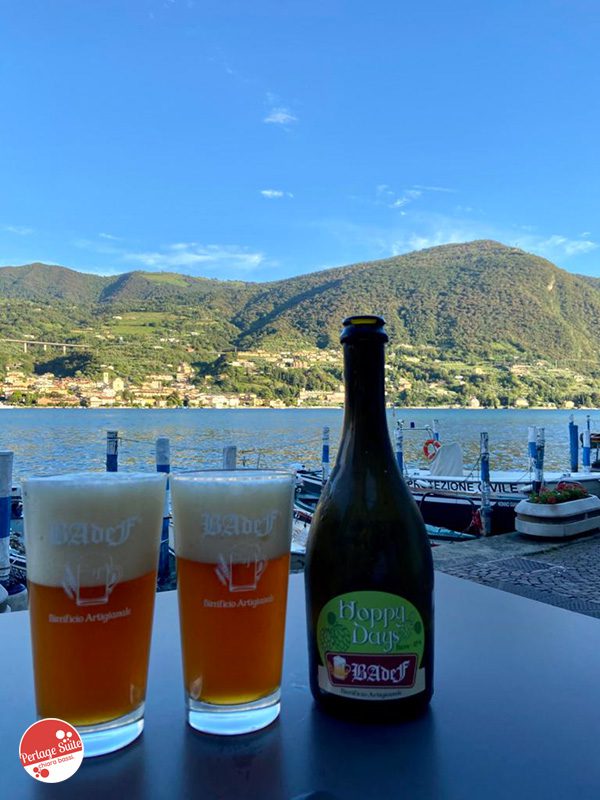Since theOktoberfest 2020, the beer festival largest and most famous drink in the world, was cancelled due to Coronavirus, I decided to dedicate an entire week to this fabulous drink by writing 7 educational articles theme. In particular, I will explain what beer ingredients are and why selecting them carefully is so important, how beer is made, beer styles, tasting and beer-food pairing. I hope you like this idea of mine, let me know in a comment! 😊 I chose as the cover of this educational article this delightful cartoon by Nicola Brusco featuring his character Dino da Sandrà that I am in love with! I hope Nicola will like it and I hope that - between a pearà and a beer - sooner or later we will do a project together! In the meantime follow him on Instagram!
Do you know that until a few years ago I didn't appreciate beer? Unfortunately, I only drank the commercial beers, the worst you can find in supermarkets... and I had no idea that craft beer even existed. In fact, I didn't even know anything about its production or that there were so many types of beer (beer styles indeed!). I would like it if after reading this article, even some sceptics who persist in thinking that beer is not good (trust me, they do exist!) would try drinking a proper beer, maybe a Indian Pale Ale (IPA) beer which is my favourite! Wanna bet he changes his mind? 😎 🤩
How is beer made?
Did you know that the first document showing us a beer recipe was dated around 3500 BC? You would be amazed at how well this historic process has stood the test of time! Before we tell you the beer recipe step by step, however, let's look at the ingredients together. In fact, to make a good beer it is more crucial than ever to choose the right raw materials.
Beer ingredients: cereals
You can brew with any type of cereal provided you make its sugars/starch fermentable. In fact, starches are naturally infermentescible complex sugars. This 'obstacle' can be overcome by a simple cooking or 'malting' process. The concept is that the long chains of starch must be broken down to transform it into simpler sugars such as maltose and dextrins.
The most commonly used cereal is thebarley. In Italy, it must be the main ingredient and other cereals may not exceed 40% of the total cereal content, while in Belgium or England they are also used 'in purity' to produce special beers. The other most commonly used cereals are wheat, rice, oats and maize.
Beer ingredients: Hops
Hops are a herbaceous perennial plant that, like my beautiful orchid fredckleara after dark black pearl, can develop male or female flowers depending on the amount of light it receives. In hop gardens, where plants inevitably often have different exposure depending on exactly where they are located, it is not uncommon to find hops with male flowers and hops with female flowers. These flowers not only differ aesthetically (the male in nature is always more beautiful), but also have different organoleptic characteristics.
There are many varieties of hops and the taste of the beer is closely linked to the variety and type of flower developed. After the flowers have been picked, they are immediately dried in order to have a moisture content below 14%. To obtain different flavours, hops can be added 'a cotto' in the boiling wort or 'a crudo' in the maturing beer. If the whole flower is used, the beer is enriched with resins, tannins and essential oils who make their contribution to the final result.
Beer ingredients: Water
You will never get a good beer without choosing the right water in relation to the type of beer you want to make because the hardness of the water - i.e. the amount of salts - influences the result. Choosing a good water is crucial for the yield of the final product. Soft water is perfect for light beers while hard water is perfect for dark beers.
Beer ingredients: Yeast
As in wine, yeast is essential for alcoholic fermentation. There are two types of yeast that ferment at different temperatures:
- Low-fermenting yeast = ferments at temperatures between 5°C and 10°C. After triggering fermentation, it becomes dense and settles at the bottom of the fermentation vat with a jelly-like appearance. It can be reused.
- High-fermenting yeast = ferments at temperatures between 15°C and 25°C. It forms chains of cells that imprison carbon dioxide bubbles which, as they rise, push up the yeast mass that forms a kind of surface deposit. It can be reused.

In summary...
How do you make beer? To make beer you need fantastic water, one or more grains, yeast and hops! As you can see, depending on the choices you make, a multitude of results open up to you, isn't that great? If you want to delve deeper into this chapter and the whole world of wine, I recommend you buy my book How to become a Sommelier: everything you need to know about wine in one book.
I expect you tomorrow with the beer recipe! If you like, scroll down the page and leave me a comment! 😍
Cheers 🍻
Chiara
P.S. In this photo my favourite type of beer, the IPA, from a brewery in Franciacorta that from what little I have tasted works very well: Badef. As it happens, one of these days I have to go to Franciacorta not to drink wine... The photo was taken at The Island of Flavours in Peschiera Maraglio, Monte Isola.


